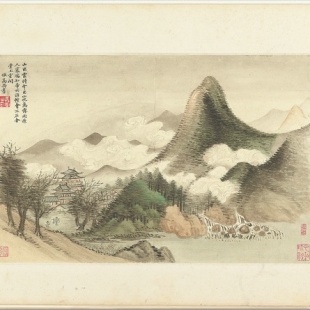Landscape of the mind


One man they both acknowledged in painting is Zhao Mengfu (1254-1322), who elucidated the idea that painting and calligraphy, by nature of their brushwork, were of the same origin.
Of the 12 leaves Wang Shimin painted, 10 are lost now. But for those who know the story — among them Joseph Scheier-Dolberg, curator of Chinese painting and calligraphy from the Metropolitan Museum of Art, great comfort could be gained from the fact that the remaining two leaves from the elder Wang were later combined with 10 surviving ones from his disciple's album to make it 12 again. And they are now on display at the US museum, in an exhibition titled Learning to Paint in Premodern China.
"Imagine that you are a talented, artistically inclined youngster from ancient China, how would you develop your skills and knowledge?" prompts the curator, whose answers come in the form of over 80 works that fill up seven galleries on the museum's second floor.
An apparent one is to learn from those who could indeed paint. Here distinction must be made between professional painters and their literati counterparts. Operating from workshops over consignments, the first group of painters typically passed their treasured means of living on to both recruited disciples and younger generations of the family. (The imperial courts were often served by generations of painting families in succession.)
To do justice to their little-acknowledged yet nonetheless indispensable role in disseminating knowledge on painting, the curator has included one piece produced by such workshops, where "groups of artists sometimes used models and templates for different element of a painting — buildings or figures for instance — that could be moved around in a modular fashion for efficient production".
The second group, whose members by definition were equally versed in painting, literature and calligraphy, tended to be more exclusive. Priding themselves on being able to create art informed by lofty texts and refined feeling, for the purpose of self-cultivation, these men — and on rare occasions women — received a holistic education that was simply beyond the reach of an average youngster.
Unless one was as talented as Wang Hui. Born into a family of professional painters, Wang Hui proved that he had more than techniques under his command. The young man caught the sharp eye of someone no less than Wang Shimin, who himself descended from a lustrous line of scholar-officials.
The result? Wang Hui was brought into the fold by the elder Wang, around whom "a critical mass of artists and collectors coalesced" to use Scheier-Dolberg's words. This enabled him among other things the viewing of hugely important works from the preceding eras, amassed by the members of this elite group who generally held the idea that history was the best teacher of all.
Words inscribed by Wang Hui on a painting of his own testified to the sense of awe he felt encountering a "small scroll" by a 10th-century painting master. "(In it) clouds and peaks race together with a luxuriant and dense air. It pierced my heart and dazzled my eyes," wrote Wang Hui, who years later commemorated that experience with his own version of billowing clouds and massive rocks "rolling toward us like a thunderstorm" to quote Maxwell Hearn, leading curator of Chinese painting in the United States and head of the museum's Asian art department. The effort was aimed at, according to the painter himself, "capturing the deep and heroic atmosphere of the north country, rather than its mere postures and prettiness".
On view at the exhibition, Wang Hui's creation may have spoken powerfully to his close friend Wang Yuanqi (1642-1715), who was also the most artistically accomplished grandson of Wang Shimin. The latter was featured in the Met show with his grandest surviving work — a 20-meterlong handscroll through which the torchbearer of his influential art family "cycled … with his interpretation of different old master styles", to use the words of Scheier-Dolberg.
"He started with Huang Gongwang (1269-1354), moved on to Huang's younger contemporary Ni Zan (1301-74) and a number of others, and then back to Huang again," the curator says. "This is effectively a visual essay on the history of Chinese painting, underlined by Wang Yuanqi's personal style. But the painter was also showing a little bit of his own training. He once wrote that 'when I was young, my grandfather (Wang Shimin) started me with Huang Gongwang'."





































